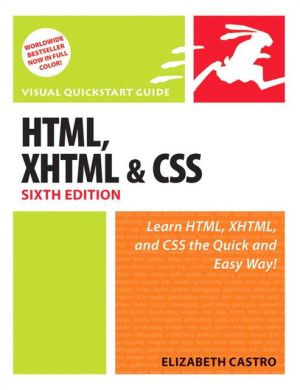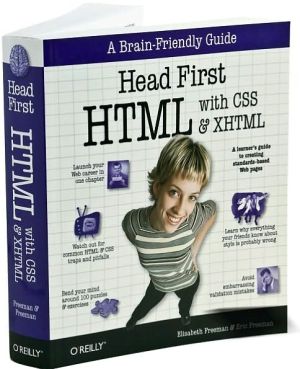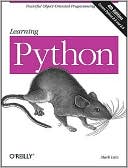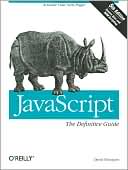Web Development and Design Foundations with XHTML
Using Hands-On Practice exercises and Web Site Case Studies to motivate readers, Web Development and Design Foundations with XHTML includes all the necessary lessons to guide students in developing highly effective Web sites. A well-rounded balance of hard skills (XHTML, CSS, JavaScript) and soft skills (Web Design, e-commerce, Web site promotion strategies) presents everything beginning Web developers need to know to build and promote successful Web sites.
Search in google:
Using Hands-On Practice exercises and Web Site Case Studies to motivate readers, Web Development and Design Foundations with XHTML includes all the necessary lessons to guide students in developing highly effective Web sites. A well-rounded balance of hard skills (XHTML, CSS, JavaScript) and soft skills (Web Design, e-commerce, Web site promotion strategies) presents everything beginning Web developers need to know to build and promote successful Web sites.
CHAPTER 1 Introduction to the Internet and World Wide Web 1 1.1 Evolution of the Internet 21.2 Internet, Intranets, and Extranets 3The Evolution of the World Wide Web 31.3 Standards and Coordination 41.4 Standards and the World Wide Web Consortium 4Accessibility and the Web 5Ethical Use of Information on the Web 61.5 Network Overview 71.6 The Client/Server Model 91.7 Internet Protocols 10File Transfer Protocol (FTP) 10E-mail Protocols 10Hypertext Transfer Protocol (HTTP) 10Transmission Control Protocol/Internet Protocol (TCP/IP) 101.8URIs, URLs, and Domain Names 12URIs and URLs 12Domain Names 131.9Markup Languages 14Standard Generalized Markup Language (SGML) 15Hypertext Markup Language (HTML) 15Extensible Markup Language (Extensible Hypertext Markup Language (XHTML) 15HTML 5–The Next Version of (X)HTML 151.10 Internet and Web Trends 16Chapter Summary 19Key Terms 19Review Questions 19Hands-On Exercise 20Web Research 21Focus on Web Design 21CHAPTER 2 XHTML Basics 23 2.1 What Is HTML? 242.2 Why XHTMLand Not HTML? 242.3 Document Type Definition 252.4 Your First Web Page 262.5 XHTML–Body and Text Basics 31The Body Element 31The Heading Element 31Accessibility and Headings 32The Paragraph Element 32The Line Break Element 34The Blockquote Element 362.6 XHTML–List Basics 37Definition Lists 37Ordered Lists 39Unordered Lists 402.7 XHTML–Text Formatting 43XHTML Logical Style Elements 43XHTML–Physical Style Elements 44Special XHTML Characters 452.8 XHTML–Hyperlinks 47The Anchor Element 47Absolute and Relative Links 48E-Mail Links 51Accessibility and Links 522.9 XHTMLValidation 53Chapter Summary 56Key Terms 56Review Questions 56Apply Your Knowledge 57Hands-On Exercises 59Web Research 60Focus on Web Design 60Web Site Case Study 60CHAPTER 3 Configuring Color and Text with CSS 75 3.1 Overview of Cascading Style Sheets 76Advantages of Cascading Style Sheets 76Types of Cascading Style Sheets 76Introduction to CSS Syntax 773.2 Using Color on Web Pages 78Web Color Palette 79Making Color Choices 80Accessibility and Color 803.3 Configuring Color with Inline CSS 81The Style Attribute 813.4 Configuring Color with Embedded Styles 82The Style Element 833.5 Configuring Text with CSS 86CSS and Fonts 863.6 The Classand IdSelectors 90The ClassSelector 90The IdSelector 913.7 The Divand SpanXHTMLElements 933.8 Using External Style Sheets 953.9 Centering XHTMLElements with CSS 99Center the Page Content 1003.10 CSS Validation 101Chapter Summary 104Key Terms 104Review Questions 104Apply Your Knowledge 105Hands-On Exercises 107Web Research 109Focus on Web Design 110Web Site Case Study: Implementing CSS 111CHAPTER 4 Visual Elements and Graphics 121 4.1 Configuring Lines and Borders 122The Horizontal Rule Element 122The borderand padding Properties 1224.2 Types of Graphics 127GIF Images 128JPEG Images 130PNG Images 1324.3 Using Graphics 132The Image Element 132Accessibility and Images 133Image Links 136Background Images 138Configuring Background Images with CSS 1404.4 XHTML Images and More 142Image Maps 142Thumbnail Images 145The Favorities Icon 145Advanced Techniques: Image Slicing 1464.5 Sources and Guidelines for Graphics 146Sources of Graphics 146Guidelines for Using Images 147Accessibility and Visual Elements 148Chapter Summary 150Key Terms 150Review Questions 150Apply Your Knowledge 151Hands-On Exercises 153Web Research 155Focus on Web Design 155Web Site Case Study: Using Graphics 155CHAPTER 5 Web Design 169 5.1 Web Site Organization 170Hierarchical Organization 171Linear Organization 174Random Organization 1745.2 Web Site Navigation–Best Practices 175Ease of Navigation 175Navigation Bars 175Short Pages 178Table of Contents 178Site Map and Site Search Features 1795.3 Design Principles 180Repetition: Repeat Visual Elements throughout Design 180Contrast: Add Visual Excitement and Draw Attention 181Proximity: Group-Related Items 181Alignment: Align Elements to Create Visual Unity 1815.4 Web Page Design–Best Practices 181Load Time 182Perceived Load Time 183Above the Fold 183Web Page “Real Estate” 183Horizontal Scrolling 184Adequate White Space 184Target Audience 184Browser-Friendly 186Screen Resolution 187Wireframes and Page Layout 1875.5 Page Layout Design Techniques 189Ice Design 189Jello Design 190Liquid Design 1905.6 Text Design–Best Practices 1925.7 Graphic Design–Best Practices 1935.8 Design to Provide Accessibility 197WCAG 2.0 Quick Reference List 1985.9 Best Practices Checklist 199Chapter Summary 203Key Terms 203Review Questions 203Hands-On Exercises 204Web Research 208Focus on Web Design 208Web Site Case Study: Web Design Best Practices 209CHAPTER 6 Page Layout with CSS 213 6.1 CSS Page Layout Overview 214Advantages of Using CSS for Page Layout 216Disadvantages of Using CSS for Page Layout 2176.2 The Box Model 2176.3 CSS Positioning Properties 220Relative and Absolute Positioning 220The floatProperty 224The clearProperty 226The overflowProperty 227The displayProperty 229The z-indexProperty 2296.4 Exploring CSS Page Layout 2366.5 Two-Column Page Layout 2406.6 CSS Debugging Tips 246CSS Debugging Techniques 2466.7 CSS Page Layout Resources 247Chapter Summary 249Key Terms 249Review Questions 249Apply Your Knowledge 250Hands-On Exercises 253Web Research 255Focus on Web Design 255Web Site Case Study: Implementing CSS Two-Column Page Layout 255CHAPTER 7 More on Links, Lists, and Layout 271 7.1 Another Look at XHTML Hyperlinks 272More on Relative Linking 272Relative Link Examples 272Opening a Link in a New Browser Window 273Linking to Fragment Identifiers 2737.2 CSS Pseudo-Classes and Links 2767.3 CSS Navigation Layout Using Lists 2817.4 Three-Column CSS Page Layout 2837.5 CSS Styling for Print 2917.6 CSS Styling for the Mobile Web 2947.7 The “Cascade” 297Chapter Summary 301Key Terms 301Review Questions 301Apply Your Knowledge 302Hands-On Exercises 305Web Research 306Focus On Web Design 307Web Site Case Study: Navigation Links in a List 307CHAPTER 8 Tables 311 8.1 Using Tables on Web Pages 312Overview of an XHTML Table 312XHTML Table Headings 313XHTML Table Captions 313XHTML Table Attributes 315Applying Attributes to Rows and Cells 318Accessibility and Tables 322XHTML Table Row Groups 3248.2 XHTML–Table Page Layout 325Accessibility and Layout Tables 326More Sample Page Layout Tables 327Flexible and Fixed Table Widths 328Nested Tables 3318.3 Using CSS to Style a Table 333Chapter Summary 339Key Terms 339Review Questions 339Apply Your Knowledge 340Hands-On Exercises 342Web Research 343Focus on Web Design 344Web Site Case Study: Using Tables 344CHAPTER 9 XHTML Forms 351 9.1 Overview of Forms 3529.2 XHTML–Using Forms 353The Form Element 355Form Controls 3579.3 Form Enhancements 369The Label Element 369The Fieldset and Legend Elements 370The tabindexAttribute 371The accesskeyAttribute 371Accessibility and Forms 371Image Buttons and the Button Element 3739.4 Using CSS to Style a Form 374Styling Forms with Tables and CSS 375Styling Forms with Only CSS 3769.5 Server-Side Processing 378Steps in Utilizing Server-Side Processing 379Privacy and Forms 381Server-Side Processing Resources 382Exploring Server-Side Processing Technologies 382Chapter Summary 384Key Terms 384Review Questions 384Apply Your Knowledge 386Hands-On Exercises 387Web Research 389Focus on Web Design 390Web Site Case Study: Adding a Form390CHAPTER 10 Web Site Development 399 10.1 Successful Large-Scale Project Development 400Project Manager 400Information Architect 400Marketing Representative 400Copywriter and Editor 400Content Manager 400Graphic Designer 401Database Administrator 401Network Administrator 401Web Developer 401Project Staffing Criteria 40110.2 The Development Process 401Conceptualization 403Analysis 404Design 404Production 406Testing 406Launch 409Maintenance 409Evaluation 40910.3 Domain Name Overview 409Choosing a Domain Name 410Registering a Domain Name 41110.4 Web Hosting 411Web Host Providers 411Hosting Needs 41210.5 Choosing a Virtual Host 413Chapter Summary 416Key Terms 416Review Questions 416Hands-On Exercises 417Web Research 420Focus on Web Design 421Web Site Case Study: Testing Phase 421CHAPTER 11 Web Multimedia and Interactivity 423 11.1 Helper Applications and Plug-Ins 42411.2 Multimedia File Types 425Obtaining Multimedia Files 42611.3 Using Sound on a Web Page 427The Object Element 42811.4 Podcasting Overview 43211.5 Using Video on a Web Page 433The Object Element 433Internet Explorer Only Option 43611.6 Browser Compatibility and Accessibility 43611.7 Copyright Issues and Media Files 43611.8 Adobe Flash 437Common Uses of Flash 438Web Design and Flash 439Adding a Flash Animation to a Web Page 440Flash Resources 44311.9 Java 443Common Uses of Java Applets 444Adding a Java Applet to a Web Page 446Free Java Applet Resources 44911.10 JavaScript 449Common Uses of JavaScript 450Free JavaScript Resources 45111.11 Dynamic HTML (DHTML) 451Common Uses of DHTML 452Sources of Free DHTML 45211.12 Ajax 453Common Uses of Ajax 454Ajax Resources 45511.13 Accessibility and Multimedia/Interactivity 455Chapter Summary 457Key Terms 457Review Questions 457Apply Your Knowledge 458Hands-On Exercises 460Web Research 461Focus on Web Design 462Web Site Case Study: Adding Multimedia 462CHAPTER 12 E-Commerce Overview 469 12.1 What Is E-Commerce? 470Advantages of E-Commerce 470Risks of E-Commerce 47112.2 E-Commerce Business Models 47212.3 Electronic Data Interchange (EDI) 47212.4 E-Commerce Statistics 47312.5 E-Commerce Issues 47412.6 E-Commerce Security 475Encryption 475Integrity 476Secure Sockets Layer (SSL) 477Digital Certificate 478SSL and Digital Certificates 47912.7 Order and Payment Processing 480Cash Model 480Check Model 480Credit Model 480Smart Card 48112.8 E-Commerce Storefront Solutions 482Instant Online Storefront 482Off-the-Shelf Shopping Cart Software 483Custom-Built Solution 483Semi-Custom-Built Solutions on a Budget 483Chapter Summary 485Key Terms 485Review Questions 485Hands-On Exercise 486Web Research 488Focus on Web Design 489Web Site Case Study: Adding a Catalog Page for an Online Store 489CHAPTER 13 Web Promotion 503 13.1 Search Engine Overview 50413.2 Popular Search Engines 50413.3 Components of a Search Engine 505Robot 505Database 505Search Form 50513.4 Designing Your Pages for Promotion 506Keywords 506Page Titles 506Heading Tags 506Description 507Meta Tags 507Linking 508Page Layout 508Images and Multimedia 508Valid Code 508Content of Value 50813.5 Listing in a Search Engine and Search Index 509Preferential Placement 509Map Your Site 511Alliances 51213.6 Monitoring Search Listings 51213.7 Link Popularity 51413.8 Social Media Optimization 515Social Bookmarking 515Blogs and RSS Feeds 515Social Networking 51513.9 Other Site Promotion Activities 516Affiliate Programs 516Banner Ads 516Banner Exchange 517Reciprocal Link Agreements 517Newsletters 518Sticky Site Features 518Personal Recommendations 518Web Rings 519Newsgroup and Listserv Postings 519Traditional Media Ads and Existing Marketing Materials 51913.10 Serving Dynamic Content with Inline Frames 519Chapter Summary 524Key Terms 524Review Questions 524Hands-On Exercises 525Web Research 526Focus on Web Design 527Web Site Case Study: Meta Tags to Promote Web Sites 527CHAPTER 14 A Brief Look at JavaScript 531 14.1 Overview of JavaScript 53214.2 The Development of JavaScript 53214.3 Popular Uses for JavaScript 533Alert Message 533Popup Windows 533Browser Sniffing 534Jump Menus 534Mouse Movement Techniques 53514.4 Adding JavaScript to a Web Page 536The Script Element 536JavaScript Statement Block Template 536Practice with Debugging 53914.5 Document Object Model Overview 54014.6 Events and Event Handlers 54214.7 Variables 546Writing a Variable to a Web Page 546Collecting Variable Values Using a Prompt 54814.8 Introduction to Programming Concepts 550Arithmetic Operators 550Decision Making 551Functions 55414.9 Form Handling 55714.10 Accessibility and JavaScript 56314.11 JavaScript Resources 564Chapter Summary 565Key Terms 565Review Questions 565Apply Your Knowledge 567Hands-On Exercises 568Web Research 569Web Site Case Study: Adding JavaScript 569Web Developer’s Handbook Appendixes 575 A. XHTMLReference 577B. Special Characters 607C. CSS Property Reference 611D. Comparison of HTML4, XHTML, and HTML5 621E. Section 508 Standards 633Answers 635Index 655








